Medium: oil on canvas mounted on panel
Dimensions: 28 5/8 x 16 1/2
Note: At some point, under the direction of an unknown party, the
painting was restretched and reduced in size by several inches at each side (see
Surteesvol. 1, 12-13).
Signature: D.G.R.
Date on Image: March 1850
Note: The monogram and date are inscribed at lower left.
Production Date: 1850 March
Exhibition History: National Institution, Portland Gallery, 1850 (no.225); R.A., 1883 (no.288); Whitechapel 1883 (no.16); Manchester 1911 (no.1210); Amsterdam, 1936 (no.130); Paris
1938 (no.115); Tate 1948 (no.20); R.A., 1973 (no.37); Tate 1984 (no.22)
Patron: Francis MacCracken
Date Commissioned: 1853
Original Cost: £50
Model: Christina Rossetti
Note: Christinia Rossetti sat for the Virgin initially.
Model: Miss Love
Note: Miss Love, a professional model, sat for the Virgin's hair.
Model: Maitland
Note: Maitland was one of three professional models who sat for the angel Gabriel.
Model: Lambert
Note: Lambert was one of three professional models who sat for the angel Gabriel.
Model: White
Note: White was one of three professional models who sat for the angel Gabriel.
Model: William Michael Rossetti
Note: WMR sat for the angel Gabriel's head.
Model: Thomas Woolner
Note: Woolner sat for the angel Gabriel's head.
Repainting: 1874
DGR did some very slight retouching in 1874, when Graham bought the painting. DGR probably
oversaw the restretching of the picture at this time, when it was given its present frame.
“The original frame evidently bore latin mottoes, copies from a brass or
brass-rubbing owned by F. G. Stephens, which were ‘Popish’ in
sentiment” (
The Pre-Raphaelites, Tate 1984, 73).
Provenance
Current Location: Tate Gallery
Catalog Number: 1210
Purchase Price: £840
Archival History: Fraces MacCraken; Christie's sale March 31, 1855 (lot 83), £79. 16
s.; Pearce; John Heugh; Christie's April 25, 1874 (lot 153), £388. 10
s.; William Graham; Christie's sale April 3, 1886 (lot 113), £840.; Tate Gallery
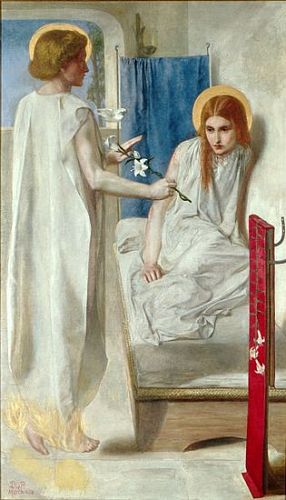
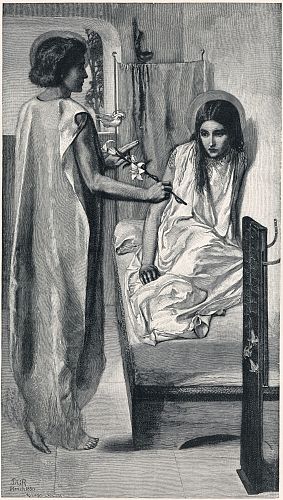
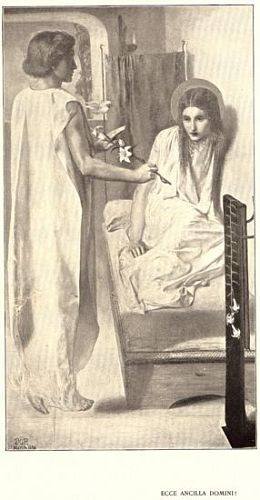
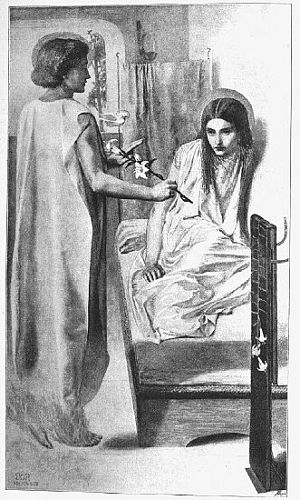
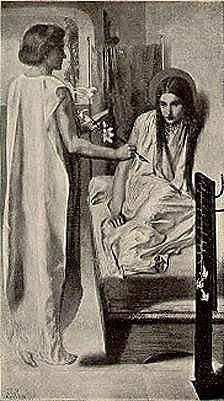
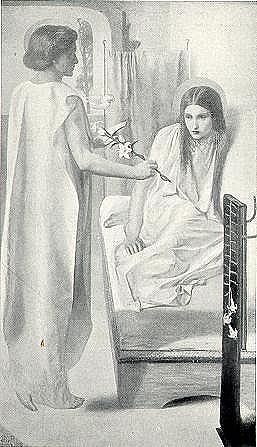
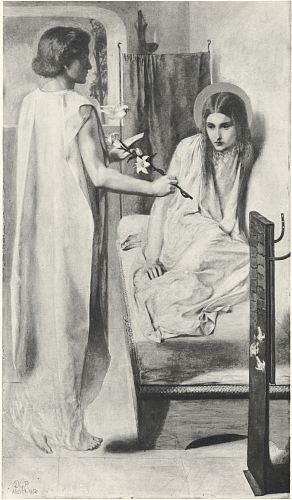
Scholarly Commentary
Introduction
Even more clearly than its companion work The Girlhood of Mary Virgin , this painting defines the difference between the early Pre-Raphaelite style of DGR and that of his contemporaries, especially Millais and Hunt. All the Pre-Raphaelites incline to the “primitive” in their preference for primary colors and color purity. The close rendering of minute detail, which Hunt especially promoted, was less important to DGR, who used close detail in more selective ways. Most important, however, is DGR's impulse to recapture certain non-illusionistic symbolic techniques of dugento and trecento primitive art. His notorious disconnect with rules of perspective has been poorly understood by later critics and art historians, who fail to see that his impatience with systematic illusionism is a function of his attachment to other techniques of pictorial spatialization. There is a strong element of pastiche in all of DGR's work that is especially apparent in his earlier pictures and writings.
If looked at from the perspective of Cimabue or even Giotto, the sight lines of Ecce Ancilla Domini! present no difficulty. On the other hand, if studied through the illusionistic conventions of Albertian perspective, the painting will appear hopelessly confused, and will produce a comment like Waugh's, that DGR “knew nothing of perspective” (Waugh22). This charge, levelled at DGR from the beginning, fails to appreciate his determination to recover certain primitive ways of apprehending and representing space. In this painting, for instance, as in so many primitive pictures, recessive space and volume are constructed in separate areas of the work but these distinct parts are not forced to cohere into a single, systematically organized spatial illusion. The result is that we are drawn into the painting at different angles. The different spatial moments that focus our attention shift and change, and when these shifts occur our sense of the general organization of the picture also shifts.
A key point of focus is the lily held by the angel. The stem defines the strongest diagonal in the picture, and the stemmed flower is carefully located at the picture's golden mean. Because of the peculiar arrangement of the planes and sight-lines, however, DGR constructs an arresting ambiguity at this crucial location: in one view the stem is pointing toward the womb of the seated Virgin, but in another it lies athwart her, with the lower part of the stem set forward of the upper. That central ambiguity indexes all the other estranged sightlines and localized compositional areas. The stand holding the embroidered lily, like the angel's lily, functions in two perspectives simultaneously: one along the lily's disharmonic diagonal, the other along the sightlines defined by the floor. The window's recess draws both window-aperture and back wall out of perspective with the floor lines and the bed, but with a clear symbolic intent: to set the outer blue “sky” along the lily's diagonal, thus angling that sky toward the Virgin; and (in a very different spatial arrangement) to put angel and Virgin in parallel planes with parallel blue backgrounds.
The dominance of white and white shadings in virtually all the planes further erodes the sense of spatial recession. There is clear volume in the picture, but as the angel's lily so dramatically shows, the volume is ambiguous and finally abstract, a nonrealistic space for arranging various kinds of symbolic relations. DGR was quite aware that Whistler's later, famous “white paintings” took their inspiration from this picture's formal experiment with the color white.
The picture is more than anything else DGR's representation of certain technical qualities of dugento and trecento painting that he most admired. Those qualities signify painting's obligation to display nonrationalized apprehension. His later, much more decorative work, so different from this in so many ways, as Ruskin and Hunt lamented, does not depart very far from the basic committments evident in this painting.
Like The Girlhood of Mary Virgin this picture is therefore another programmatic work. In point of expressive force, however, it goes well beyond DGR's first oil painting, which seems formal and brainy beside Ecce Ancilla Domini!. DGR's return to the Italian “primitives” was an effort to recover a kind of magical artistic practice which he saw in their work. Two things in Ecce Ancilla Domini! lift the painting past its strictly conceptual goals. First, we get a distinct sense of the catastrophic effect of a divine intervention in nature in the contrast between the hieratic figure of the angel and the contorted body of the Virgin with her brooding and haunted eyes. Second, the painting's strange series of white variations seems oddly obsessional, suggesting the presence of inexplicable yet plainly purposive agency.
Production History
DGR's initial sketch for the picture was begun on 25 November 1849. By 8 December he had begun the painting itself and he worked steadily at it until the opening of the Portland Gallery Exhibition in late spring 1850. (WMR29-71 passim). As the picture didn't sell, he reworked parts of it in December 1859 (WMR83-85) and made final changes in January 1853 after it had been purchased by MacCraken (WMR99). It was at this time that DGR renamed the picture The Annunciation, “to guard against the imputation of ‘popery’”, as WMR wrote in his diary.
Reception
See Ghose, 29-41; Ruskin, Three Colours of Pre-Raphaelitism, XXXIV. 166.
Iconographic
The usual paraphernalia of the Annunciation are present, several of the accessories having been brought over directly from this work's companion piece, The Girlhood of Mary Virgin . Those (as it were) intramural connections underscore the programmatic character of DGR's painting.
As with DGR's The Girlhood of Mary Virgin , this work's standard Christian iconography is handled in a pastiche manner. What this means is that both paintings represent an act of pictorial rather than religious devotion. The subject of DGR's picture is art rather than religion, but an art that is invested with spiritual values and commitments.
Placing the Virgin in her bed is an original conception, as Ruskin was the first to point out. DGR seems to have lifted the idea from his reading in Anna Jameson (see her Sacred and Legendary Art (I. 125).
The idea of a virginal conception is iconographically handled in the phallic lily which points at Mary's womb. The tree outside the window is oddly presented without any associated landscape. DGR may have wanted to isolate it in this way in order to emphasize its purely iconographic character (i.e., as an allusion to the tree in the Garden of Eden by which man's fall came about, the tree of Jesus's crucifixion by which redemption came, and perhaps the tree of Jesse, the redeemer's genealogical line.
Pictorial
This picture has a close relation, in both style and theme, to the first oil painting, The Girlhood of Mary Virgin , executed just before this one. Indeed, the cloth that Mary is represented as embroidering in The Girlhood of Mary Virgin appears in this painting beside the Virgin's bed, as does the “angel-watered lily” (here borne by the angel Gabriel) and the dove-image of the Holy Spirit. DGR intended to do another painting, to be called Death of the Virgin, to accompany this work but it was never begun.
The fullest discussion of pictorial influences is Grieve's (Grieve21-24); he draws particular attention to DGR's admiration for Flandrin. Faxon notes the possible influence of the outer panels of Van Eyck's altarpiece at Ghent , which DGR had seen and greatly admired, and she also cites plate 7 of the British Library's Canticum canticorum (Faxon55). The 1850 reviewer for the Observer thought the picture was done in the manner of Pietro Perugino and the review for the Times was reminded of plates in medieval missals. The Virgin's pose distinctly recalls Simone Martini's famous Annunciation altarpiece done for the Siena Cathedral (now in the Uffizi Gallery). Other possible influences would be Botticelli's famous Uffizi Annunciation and Roger Van der Weyden's Annunciation (in the Louvre).
Literary
The picture has its source in the gospel of Luke I: 26-35, especially verses 28-29.
The painting relates directly to the sestet of DGR's sonnet Mary's Girlhood (For a Picture) I. , which DGR wrote to accompany the painting that pairs with this one, The Girlhood of Mary Virgin .
DGR's striking representation of the Virgin probably owes as much to Vasari's report of Giotto's Annunciation in his Life of that artist as it does to paintings and images that DGR saw: “The Virgin seems almost ready to take flight, so great is her fear and astonishment as she receives the salutation of Gabriel”.
The famous “whiteness” of this painting may well owe more to Dante than to any painting; it recalls the relief images of the Annunciation that Dante sees in Canto X of the Purgatorio, which are carved in white marble.
Bibliography